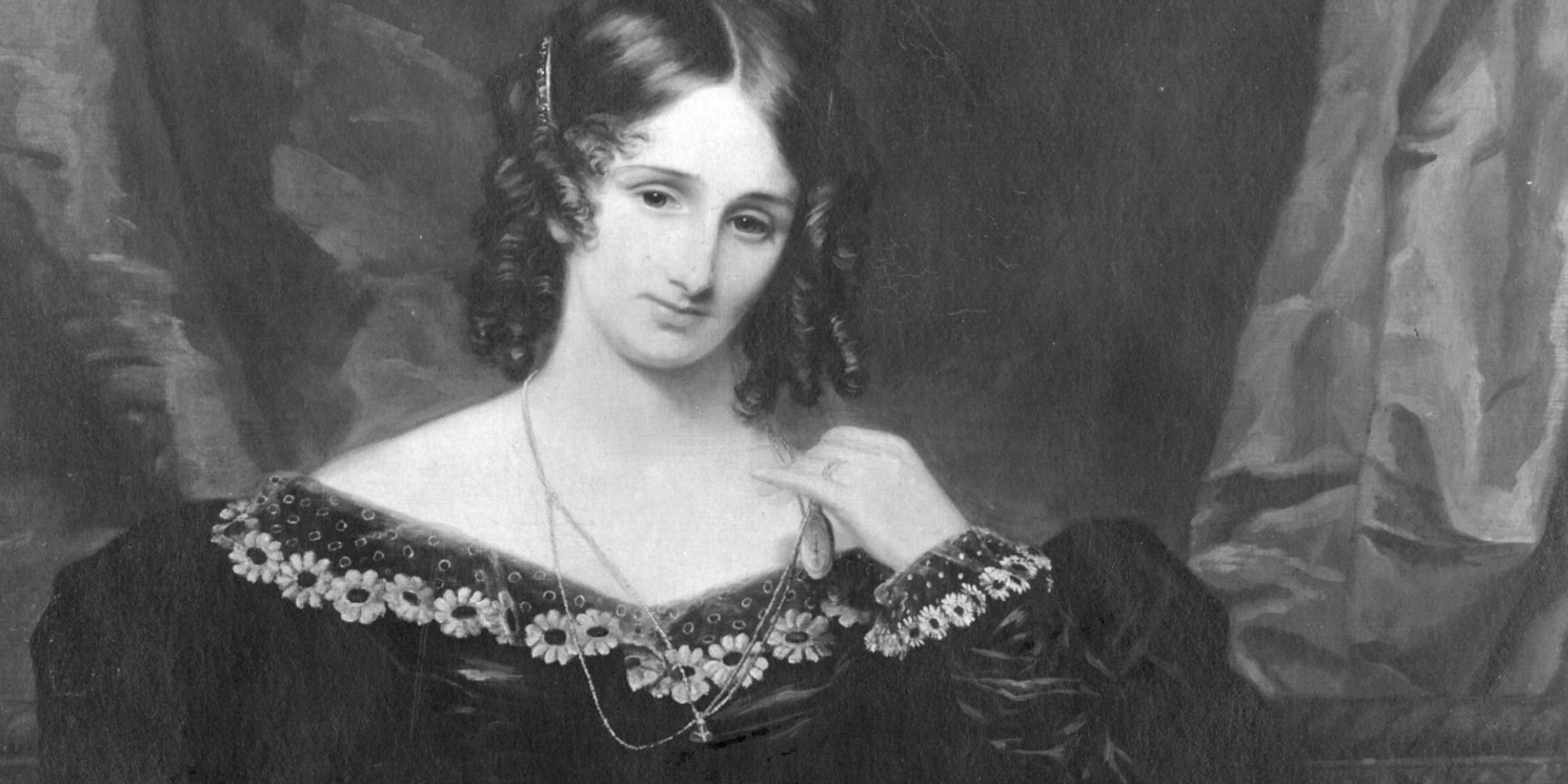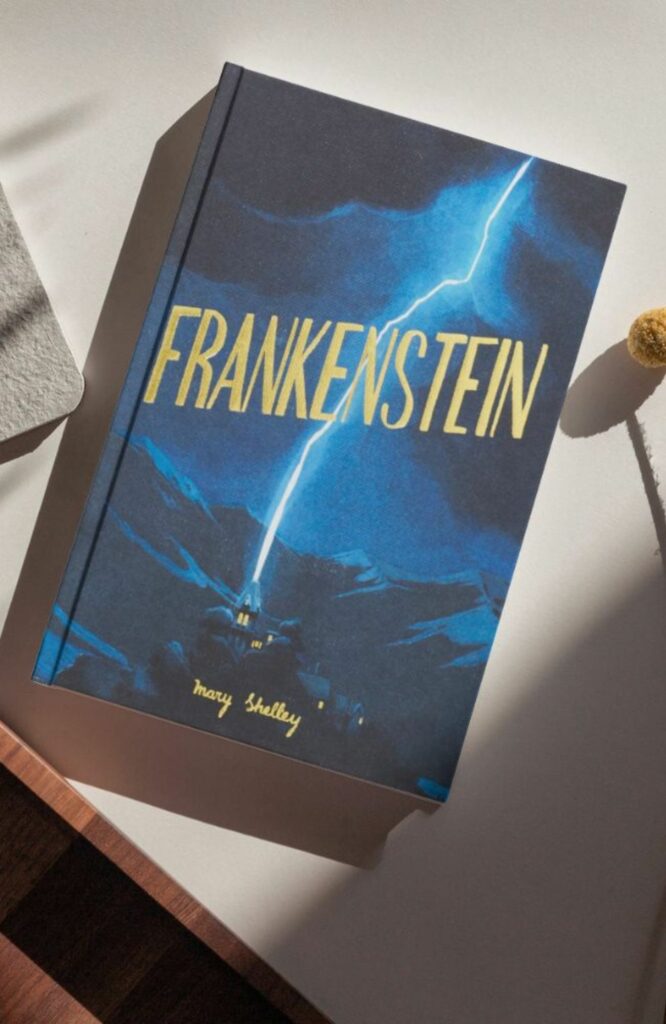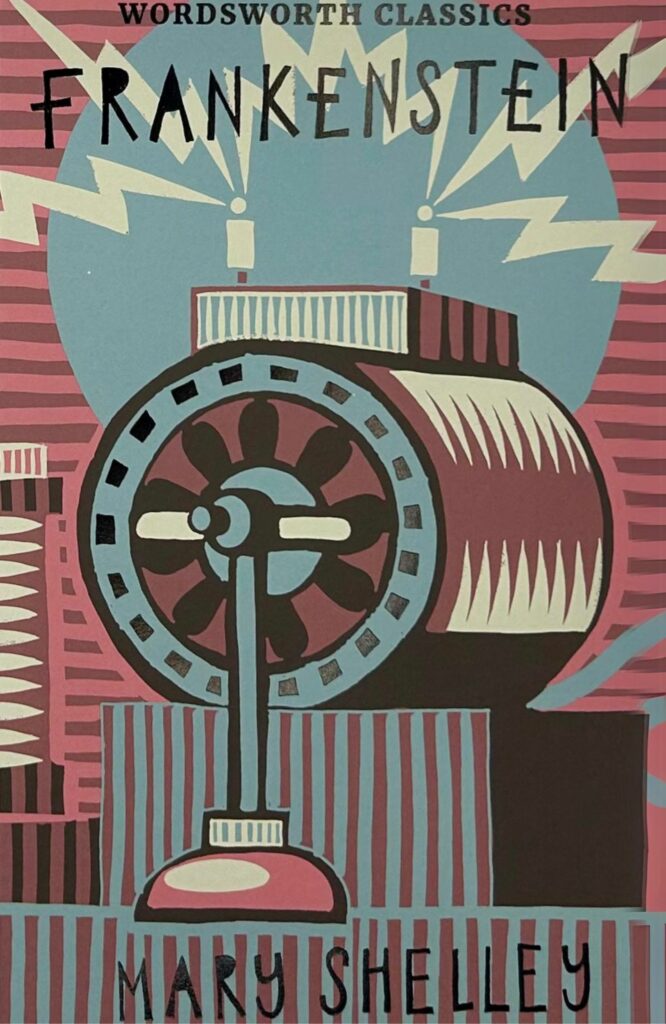
Frankenstein 200
Sally Minogue re-evaluates Mary Shelley’s Frankenstein on the 200th anniversary of the first, 1818 edition
‘When I placed my head upon my pillow, I did not sleep, nor could I be said to think. My imagination, unbidden, possessed and guided me, gifting the successive images that arose in my mind with a vividness far beyond the bounds of reverie. I saw – with shut eyes, but acute mental vision – I saw the pale student of unhallowed arts kneeling beside the thing he had put together. I saw the hideous phantasm of a man stretched out, and then, on the working of some powerful engine, show signs of life, and stir with an uneasy, half-vital motion.’ (4) Thus Mary Shelley describes the moment when she conceived the monstrous act of creation at the centre of her novel Frankenstein. As Shelley herself puts it, ‘Frightful it must be; for supremely frightful would be the effect of any human endeavour to mock the stupendous mechanism of the creator of the world. His success would terrify the artist; he would rush away from his odious handiwork, horror-stricken.’ (4) Does Shelley know here that in describing her protagonist Victor Frankenstein’s hubris in usurping the supreme position of ‘the creator of the world’, she is also describing her own extraordinary act of imagination as a writer? Writers are indeed the ultimate creators since the known world does not hold them – they can leap beyond its bounds and bring new forms to life.
Shelley’s was an act of double daring – to imagine the defying of a religious principle stronger in her own day than in ours, and to depict it in a way that makes it understandable both from Frankenstein’s point of view and from that of his creation. Victor Frankenstein’s is a purely human act; no special spark to ignite the soul is needed to produce his creation, other than the galvanic spark of electricity (as we assume – Shelley is admirably vague about what actually is ‘the cause of generation and life’ which enables Frankenstein to bestow ‘animation upon lifeless matter’ [41]). He is soundly punished for his act; but it remains a purely scientific act, and moreover a thinkable act. And his creation – never named, though for many years he has been conflated with his creator so that in the popular imagination he is Frankenstein – that creation is not, when he is brought to life, a monster in moral terms. He only looks like a monster, because of the origins of his parts. And perhaps Victor’s own horror at his eventual creation stems from the associations of those origins: ‘Who shall conceive the horrors of my secret toil, as I dabbled among the unhallowed damps of the grave, or tortured the living animal to animate the lifeless clay? … The dissecting room and the slaughterhouse furnished many of my materials, and often did my human nature turn with loathing from my occupation.’(43) It is the Creature’s treatment at his creator’s hands and those of other humans that turns him into the vengeful murderer he becomes. So in fact Frankenstein’s act of creation is not necessarily itself fearful; the implication of the narrative arc of the novel is that if the Creature had been treated as a human being, like other humans, he could have prospered. It is the human world itself that turns him into the monster he becomes.
It’s not surprising in one way that Mary Shelley was capable of such a revolutionary story, one which attacks the very basis of the way human beings see their own place in the world. She was the daughter of two famous free thinkers, William Godwin and Mary Wollstonecraft, radical in both their political and their sexual lives, who married each other only reluctantly when Mary herself was conceived. She was brought up – after her mother’s death in the immediate aftermath of Mary’s birth – initially by her father, alongside her half-sister Fanny Imlay, her mother’s first, illegitimate child by Gilbert Imlay. Then when Mary was three, Godwin married his neighbour Mary Jane Clairmont, who brought two children with her, including Jane – to be Claire – Clairmont, who would play a constant part in the story to come. Mary’s upbringing was literary and intellectual; like Elizabeth Barrett and Virginia Stephen after her, she was given full access to her father’s library and his liberal encouragement; and she was often present at his discussions with friends such as Coleridge and Hazlitt. But she felt that her stepmother resented her – which after all may only be a way of saying that Mary resented her stepmother.
In this climate and social milieu she first met Percy Bysshe Shelley, in 1812. Two years later he and Mary began a liaison, and in July 1814 they eloped to France. Mary was 16; they left behind them Shelley’s pregnant wife Harriet, whom he had married when she was also 16. Mary too was pregnant and in February 1815, now back in England, gave birth to a daughter who died less than a fortnight later. Almost immediately she became pregnant again, and when her son William was born in January 1816, they planned the trip that in the summer of that year would take them to Geneva, Lord Byron, and the Villa Diodati – and the birth of Frankenstein. I include these details of Mary’s emotional, sexual and reproductive life, not because she is a woman, but to indicate the highly fraught nature of this couple of years from 1814 to 1816, for herself but also for Shelley, and for those who were attached to them. Even the freest of free thinkers may be tested by the day to day nature of a free life lived out.
Whether the heightened nature of that life contributed to Mary’s extraordinary feat of imagination in producing the tale that would become the novel Frankenstein, we can’t know. Other writers have had lives of quiet sequestration and been fully as imaginative: think of Emily Brontë and Emily Dickinson. Such cases should be thought of when contemporary commentators question whether a writer can represent an identity other than their own. Mary Shelley, at 18, imagined such things that were beyond the bounds of any identity or gender, perhaps beyond the bounds of the known human.
Shelley herself was somewhat aghast at what she had produced. She calls it, in her 1831 Preface, 13 years after its first publication, ‘my hideous progeny’. But she also confesses affection for it, ‘for it was the offspring of happy days, when death and grief were but words’.(5) There’s an insight into her writing process here – perhaps into the writing process – since she associates the act of writing with her own personal circumstances. Whatever the horrors on the page, they were inscribed when she herself was comparatively happy; her references to ‘death and grief’ being ‘but words’ at this time allude to Shelley’s subsequent death, in 1822, in a boating accident. Shelley very much encouraged her writing, and encouraged her; whatever the complications of their life together, that much is clear. At the same time, suggestions that he was part author of Frankenstein have been firmly scotched by the work of Anne Mellor who has looked closely at his emendations of Mary’s manuscript and concluded that they are peripheral. (See Siv Jansson’s excellent introduction to the Wordsworth edition, xvi.) This Mary herself also stoutly states in her 1831 Preface, whilst recognising her deep debt to Shelley: ‘I certainly did not owe the suggestion of one incident, nor scarcely of one train of feeling, to my husband, and yet but for his incitement, it would never have taken the form in which it was presented to the world.’ (5)
So to the novel itself. At its heart is the character of the Creature. He is a tragic figure, and Shelley’s great feat is to engage the reader with him. His tragedy is that those he encounters do not see beyond the horrid facade of his outer being to his inner self. As readers, we are spared the encounter with his monstrosity, except in description, and can see the being within, also eloquently described and indeed given voice. This is the power of fiction, that it allows the Creature to speak, to tell his own story. From Chapter 11 to Chapter 16, he recounts to his creator Frankenstein his ‘growing up’. This is the deferred heart and centre of the novel, folded round by first, the epistolary narrative from Walton, who has encountered Victor Frankenstein on the frozen wastes, then by Frankenstein’s own narrative recounting of his process of creation, then the deadly aftermath of that creation with the murder of the infant William and the mistaken execution of Justine. By the time that the Creature speaks, all is stacked against him for the reader. He is the murderer of one innocent; another innocent has died wrongly. All the more extraordinary than that as we hear him speak, to his own creator, we are brought to an understanding of how such things came to be.
The very first words of the Creature show his own self-understanding and self-reflection and are at the same time conciliatory: ‘Everywhere I see bliss, from which I alone am irrevocably excluded. I was benevolent and good; misery made me a fiend. Make me happy, and I shall again be virtuous.’ (78) This is the Creature as a fallen angel (and he frequently references Paradise Lost); he tells the story of watching the de Lacey family, understanding their woes and happiness, learning language from them, and discovering the inequities of the world as they analyse them, even learning to read. And he learns the pleasure of doing small tasks for them to alleviate their difficulties. As an outcast being he worships from afar this ideal model of the human family, but is again, cruelly, outcast by them when he attempts to show himself to them, even though whilst he has remained hidden, they have taken his kindnesses as those of a ‘good spirit’ – words he hears them say but does not understand. Only the blind father takes him as he is; as soon as the rest of the family see him they assume his outward ugliness to herald inner evil and attack him – blindly.
The Creature’s tale is a microcosm of a child’s education in the world: in true Romantic fashion, he is, beneath his fearful appearance, an innocent, Rousseau’s noble savage. But for that exterior and what it heralds of horror to the ordinary human gaze, he comes ‘trailing clouds of glory’ just as much as Wordsworth’s child. He sees humanity as good, in the model of the ideal family; he learns to study beyond his immediate experience through the use of language; he reflects upon himself and his place in the world; and like any other growing human, he seeks solace in human company and the exchange of common human feeling. All his hopes are rudely shattered by his immediate horror of Felix on seeing him. There will be no felicity for the Creature, and no place on the earth where he can find comfort. Paradise is lost to him, and it is sadder because he has never been allowed to find it. He has seen it only from the outside looking in.
That he then turns to ‘a deep and deadly revenge, such as would alone compensate for the outrages and anguish I had endured’ does not, of course, justify his actions. (109) But if this is in any way a morality tale, it is one in which the creator, Victor Frankenstein is to blame, for not taking responsibility for his child. The Creature is, in that sense, a massive, unwieldy infant whom no one wants to nurture. Here we come to a further radical element in Shelley’s thinking. Her comment on the fearfulness of challenging ‘the stupendous mechanism of the creator of the world’ is thought by some to be a sop to traditional religious thinking, more necessary in 1831 than she had perceived it as being in 1818. But what remains genuinely revolutionary is her imagining of a process of creation which nullifies the mechanisms of human reproduction. If there is a warning in Frankenstein, it is in the way she shows that sidestepping the ‘natural’ processes of reproduction means also sidestepping the nurturing relationship of parent to child. The Creature is born fully formed, yet is still, within, a babe in arms. The absence of any mother figure in Frankenstein is a powerful lack.
From mid-1816 to 1817, Mary Shelley worked on her original tale to produce the first edition of the novel, published on January 1st 1818. During that time there were casualties of the complicated way of life she, Shelley and their whole circle led. His wife Harriet committed suicide late in 1816, as did Mary’s half-sister Fanny. There was a constant rumour that Percy and Claire Clairmont had been lovers. Claire, who continued to live with the Shelleys, had Byron’s child, the unlucky Allegra. Percy Shelley and Lord Byron were great artists but they rode roughshod through their human relationships. Meanwhile Mary, against all odds, quietly produced a novel which has had a more powerful cultural afterlife than any other nineteenth-century work. Frankenstein is a slim volume; but it is a great book.
Mary Shelley revised the 1818 edition substantially for its 3rd edition in 1831; that is the edition that is popularly read, and the one on which the Wordsworth edition is based. The Preface to the 1818 edition, passed off as from the anonymous author, is by Percy Shelley. In 1831 Mary Shelley wrote her own introduction. Both are available in the Wordsworth edition.
The cultural appropriation of Frankenstein in various media, but especially in film, is well documented online. On Saturday, January 13th there is a programme on BBC Radio 4 about the novel’s cultural aftermath.
There is a very extensive bibliography in the Wordsworth edition. A new addition to the rich biographical and critical material surrounding Frankenstein is a new biography: In Search of Mary Shelley: The Girl Who Wrote Frankenstein, by Fiona Sampson, Profile, 2018.
Books associated with this article

Frankenstein (Collector’s Edition)
Mary Shelley
